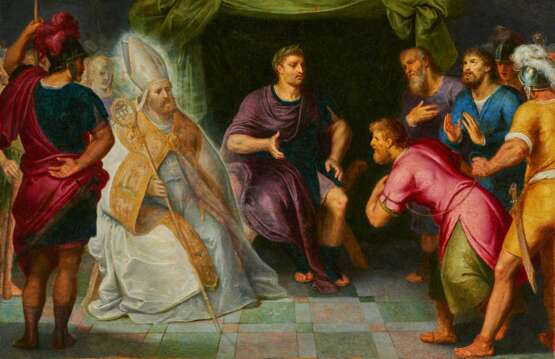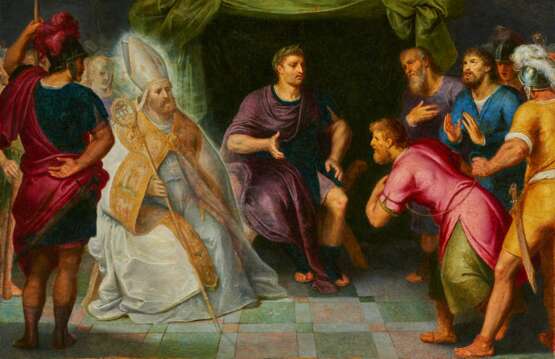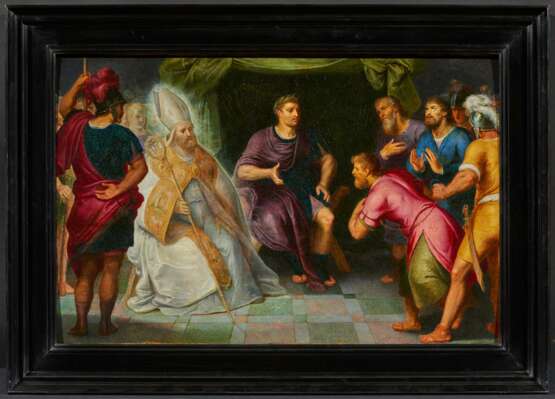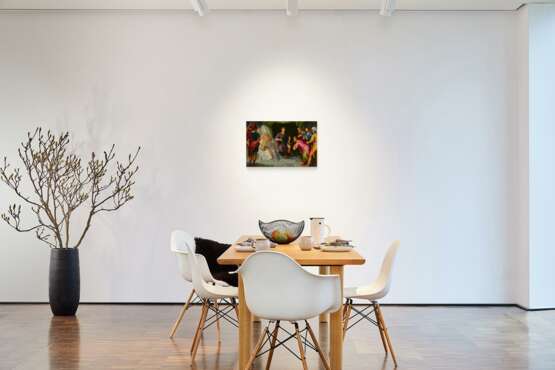ID 950885
Lot 36 | Otto van Veen
Estimate value
€ 11 000 – 15 000
1556 Leiden - 1629 Brussels
Title: Emperor Constantine and Bishop Miltiades Conduct the Council against the Donatist Heresy.
Technique: Oil on wood.
Measurement: 45 x 68cm.
Frame: Framed.
Provenance:
Private ownership, Belgium.
The present painting, which unfolds in landscape format, shows a figure wearing a laurel wreath and purple mantle in the centre of the composition. The figure is a Roman emperor of the late imperial period, when purple was the colour worn by emperors and later by Christian bishops. Next to him sits a bishop surrounded by a luminous aura, and three figures to his right appear to be engaged in a heated argument.
It is probable that the figure with the purple cloak is Emperor Constantine I, whose efforts for the unity and concord of the Church are well known: According to Constantine, the unity of the Christian world was the indispensable prerequisite for the stability of imperial power. Constantine was therefore the initiator of several councils to resolve the theological issues that divided the Church.
The first was the council convened by Arles in France, which confirmed the judgement of a commission of bishops from Rome that had condemned the heresy of the Donatists. The Council confirmed as dogmatic theology the fact that the efficacy of the sacraments does not depend on the goodness of those who administer them and on the eternal character they confer. Man, despite his efforts, can never consider himself perfect before God. On the contrary, the sacraments are to be interpreted as gifts from God, contrary to what the Donatists claim.
It is likely that the present painting depicts an episode of this council: In this case, the bishop cloaked in a luminous light is most likely Miltiades, elected around 312 AD, whom Constantine entrusted with the examination of the case.
A small painting like this, with a complex subject closely linked to the history of the Church, could not do without an educated patron with a precise political and religious vision. Perhaps the painter and his patron thereby wanted to emphasise the role of the Habsburg family in defending Catholicism in the Southern Netherlands. Indeed, the Southern Netherlands, which were subject to the Spanish Habsburgs until 1713, tended to see themselves as an integral part of the Crown, since they formed the first nucleus of the empire of Charles V, who was born in Ghent. In contrast to the Republic of the United Provinces, the society of the Southern Netherlands presented itself as inextricably linked to Catholic Spain and the Roman Church, strongly influenced by the Jesuits, repressive and aware of itself and its role.
We are grateful to Bert Schepers, Antwerp, for confirming the attribution of the present painting after examitation in the original.
| Artist: | Otto van Veen (1556 - 1629) |
|---|---|
| Applied technique: | Oil |
| Auction house category: | Old Masters |
| Artist: | Otto van Veen (1556 - 1629) |
|---|---|
| Applied technique: | Oil |
| Auction house category: | Old Masters |
| Address of auction |
VAN HAM Kunstauktionen GmbH Hitzelerstr. 2 50968 Köln Germany | ||||||||||||||
|---|---|---|---|---|---|---|---|---|---|---|---|---|---|---|---|
| Preview |
| ||||||||||||||
| Phone | +49 221 92586215 | ||||||||||||||
| Fax | +49 221 92 58 62 4 | ||||||||||||||
| Buyer Premium | 32% | ||||||||||||||
| Conditions of purchase | Conditions of purchase | ||||||||||||||
| Business hours | Business hours
|










